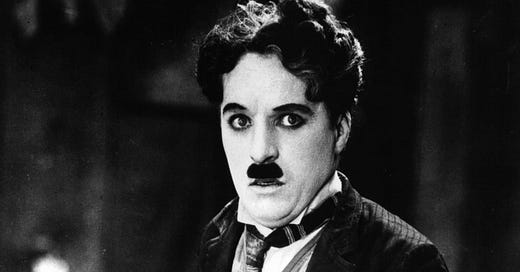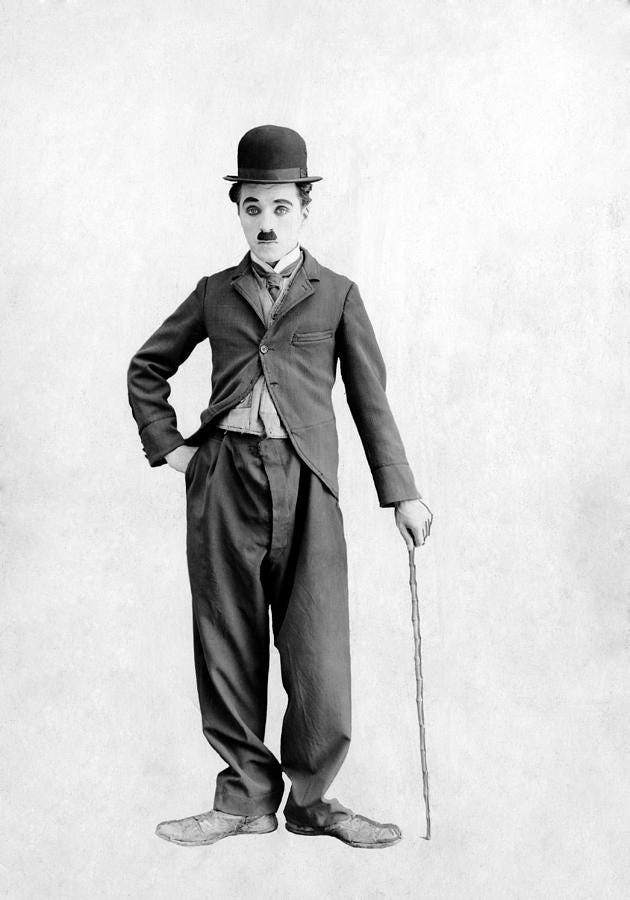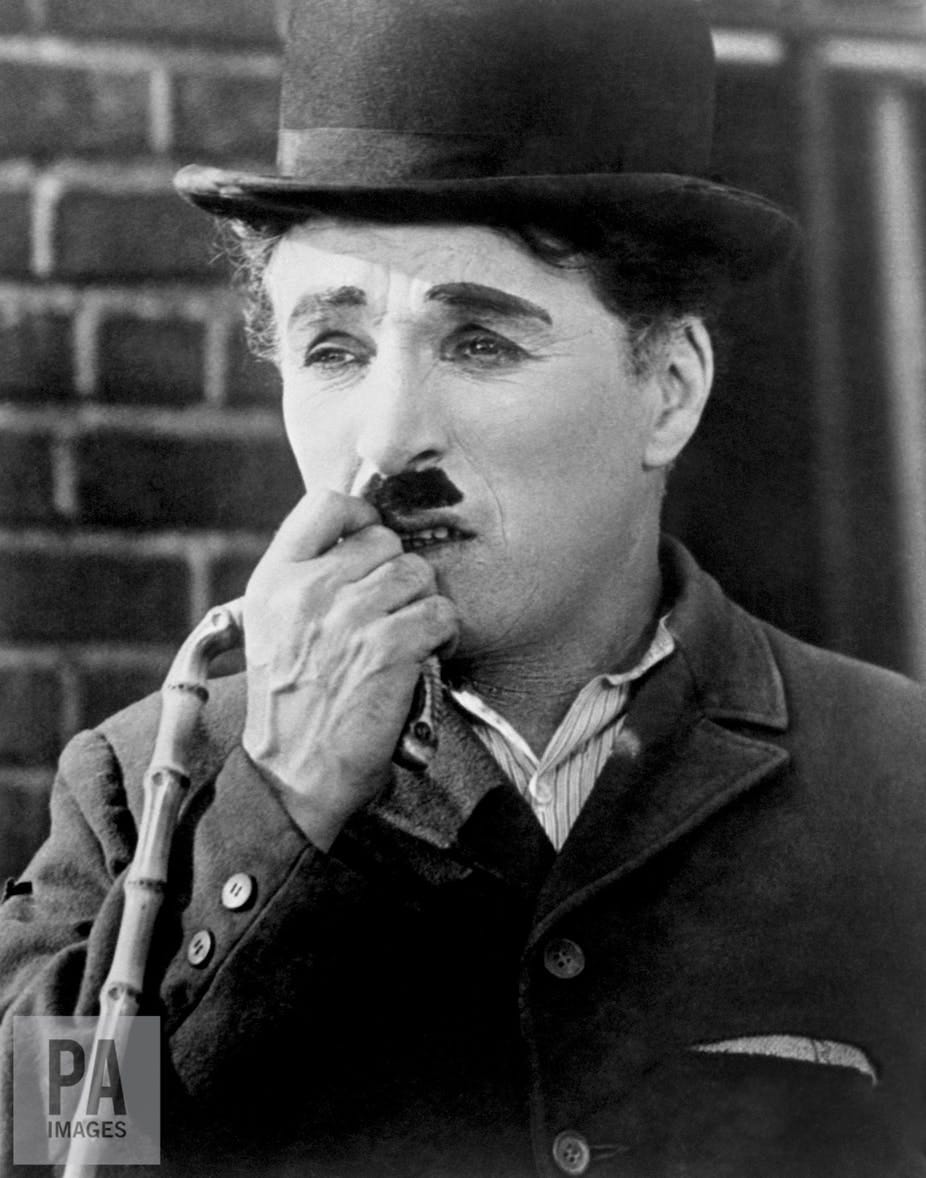Homeless Persons in History? Even Charlie Chaplin and Adolf Hitler?
By Stephen Wilson, one of our reporters abroad
StreetSense looks into the legacy of one of America's greatest performers Charlie Chaplin. We examine what was so profound about his role, how he provoked strong passions, and how his satire on capitalism and fascism was so sharp.
"America- I am coming to conquer you. Every man, woman, and child shall have my name on his or her lips: Charles Spencer Chaplin." And conquer America he did! That is if we view Chaplin in terms of his fortune, fame, and popularity as the paramount king of comedy. What might have astonished people at the time was that he won this popularity by playing the role of the tramp par excellence. He brilliantly performed the role of 'a gentleman of the road' to unsurpassed limits which practically turned the world upside down. Who would have thought that evoking sympathy for an often-despised person “the tramp” would prove to be a hit in the cinema!
The second surprising revelation was how radical Charlie Chaplin was in some of his political and social roles. For instance, he once stated, "As for politics I am an anarchist. I hate government and rules - and fetters. People must be free." One wonders how he pulled all this off. No doubt his genius must have mesmerised and captivated people. He was also a perfectionist who could infuriate so many colleagues who worked with him by insisting on endless rehearsals and reshooting.
Chaplin was prolific in his output. He must have possessed boundless energy as well as ingenuity. He seemed indefatigable. His career covered 70 years. Some of the most famous films are “The Tramp” {1915}, “The Kid” {1921}, and “The Gold Rush” {1925}. But critics think most highly of his films such as “City Lights” {1931} and “Modern Times” {1936}. The advent of the 'talking movies' with the introduction of sound did not dent his genius. His film “The Great Dictator” {1940}, a satire of Hitler, remains one of his best. But later films such as “Limelight” {1952} and “Monsieur Verdoux” {1947} are hardly disappointing.
Raising the role of tramp in the Cinema represented a real feat. At the turn of the 20th century, the tramp was a largely despised and denigrated figure. Even the two subsequent newspapers for the homeless; the “Hobo News,” editions one and two, had few kind words to say about the tramp. They looked down on him and were at pains to point out he was not a real hobo as he was not an individual who did not want to work and did not want to be deemed useless. Charlie Chaplin humanized how people perceived the tramp as well as the underdogs who were too often slighted by Americans as so called 'losers.'
So what exactly was the persona of the tramp which Chaplin dreamt up?
Chaplin himself claimed, “I wanted everything to be a contradiction: the pants baggy, the coat tight, the hat small and the shoes large. I added a small moustache, which, I reasoned, would add age without hiding my expression. I had no idea of the character. But the moment he was dressed, the clothes and the make-up made me feel the person he was. I began to know him, and by the time I walked on the stage he was fully born."
In reality, the character evolved and underwent changes. To begin with, he came across as being very vulgar, violent. and abusive—but later became more polite, kind, and humanized. If you watch some of the earliest movies you might be struck about how violent those movies are. There is a lot of slapdash kicking, punching, and biting between the characters. The Russian film director Eisenstein thought that one of the crucial features of his burlesque films was what he described as a vicious, sadistic, and humiliating attitude to children.
In Chaplin's films children were not treated 'sweetly' or 'kindly' but were mocked, teased and bullied for their failures. {See page 118 of Slavoj Zizek's “The Sublime Object of Ideology,” 2008, London and New York: Verso.} For instance, just watch a scene from “The Kid” {1921} and you see a crowd of adults being amused at watching two young children being forced to fight each other. No adults intervene to pull them apart except the tramp.
The dark side of poverty and deprivation are never far away in those films. And Chaplin, with a little exaggeration, hits on a lot of the cruel reality of homelessness. For instance, how the homeless are constantly subject to humiliation, teasing, bullying, and violence. How they are chased by either criminals or the police. It is no accident the clothes don't fit the tramp. I often hear some people in Moscow mock the appearance of the homeless by saying they wear clothes that never fit.
How come Chaplin displayed an acute awareness of poverty and homelessness? Well one of the most obvious reasons was he grew up in England in great poverty and deprivation. He was forced to go to a workhouse twice before the age of 9, spent time in an orphanage. and for a time was homeless and hungry on the streets. When Chaplin was 14, his mother was put into a psychiatric hospital for treatment. Sigmund Freud once wrote that Chaplin's films were a reenactment of his humiliating childhood in England! That might come across as a rather sweeping statement but there may be a grain of truth in this interpretation.
Despite making so many people laugh, the tramp still comes across as a disturbing figure. He seems to be a walking disaster.
He can do practically nothing right! You would not want to go ice skating in any rink he visited. In one film, “The Rink.” he accidently injures practically every skater he encounters. In the film “Modern Times” he messes everything up in a factory which practically is disrupted and destroyed by first his bungling and then his craziness. In this respect Chaplin, points out how the speed of the conveyor belt used by Henry Ford literary drives people crazy.
Chaplin exposed what many people would rather ignore or deny: the unwanted presence of homeless people who were seen as being a blot or stain on the urban landscape of the city. In the opening scene of his film “City Lights” {1931} during an opening ceremony to a new monument to 'Peace and Prosperity,' the curtain concealing the monument is lifted only to find a tramp sleeping on the monument. The tramp finds himself exposed to the gaze of the public and attempts to escape.
Did the audience always fully understand the plight of the tramp? A constant theme of those films is how people not only mistake the tramp for someone else but can't always see the intense suffering being experienced by the tramp. The Slovanik thinker Zizek, along with Michael Chion, suggest an origin of a particular kind of comedy. Zizek states, “In Chaplin's films, we even find a kind of wild theory of the origins from the blindness of the audience, i.e., from such a split caused by the mistaken gaze: in “The Circus,” for example, the tramp, on the run from the police, finds himself on a rope at the top of the circus tent; he starts to gesticulate wildly, trying to keep his balance, while the audience laughs and applauds, mistaking his desperate struggle for survival for a comedian's virtuosity—the origin of comedy is to be sought precisely in such cruel blindness, unawareness of the tragic reality of a situation.” {See page 5 of Slavoj Zizek's “Enjoy the Symptom!” 1992, New York and London: Routledge Classics}. At times you don't know whether to laugh or cry at the antics of the tramp!
It is without doubt that such films and the satire, “The Great Dictator,” led Charlie Chaplin to be hounded and banned from America in 1952 on the grounds of being a ‘communist'. The F.B.I. file on Chaplin amounted to a staggering 2000 pages. He was forced to take up residence in Switzerland for the rest of his life. In response to those accusations that he was a communist, Chaplin stated he was not and did not want a revolution. He claimed he only wanted to make people laugh and was for the principles of human decency and the right for every person to have a roof over their head. He did not want anyone to undergo the humiliating poverty and deprivation he had suffered throughout his early years.
For years Adolf Hitler was ridiculed as a German Charlie Chaplin because of his moustache and often ridiculous posturing! Many people did not take Hitler seriously and viewed him as just absurd beyond belief. But it is worth asking, “What did Adolf Hitler, if anything, have in common with Charlie Chaplin?” Well, just a few things. Both were born in 1889, both lived an early life of poverty, and both experienced a spell of homelessness. Both were charismatic in their ways and both rose to great prominence. Both had the same kind of moustache.
But Chaplin displayed an insight into Hitler's character which was very perceptive. In this regard, the English Historian A.J.P. Taylor perhaps paid Chaplin the greatest compliment. The historian claimed that whereas professional historians such as Allan Bullock and Hugh Trevor Roper got it wrong, Chaplin got it right. Hitler had not a master consistent plan for conquering the world. He was a day dreamer who constantly changed his plans to accommodate a new reality. He was essentially an opportunist. In one scene of the film you hear the dictator claim he could take over countries by using bluff rather than a war. It is worth quoting the historian. Taylor states, “Hitler himself was an amateur historian, or rather a generalist on history; and he created systems in his spare time. These systems were day-dreams. Chaplin grasped this with an artist's genius, when he showed the Great Dictator transforming the world into a toy balloon and kicking it to the ceiling with the point of his toe. Hitler always saw himself, in these day-dreams, as master of the world. But the world which he dreamt to master and the way he would do it changed with changing circumstances.” {See page 98, “The Origins of the Second World War,” 1961, London: Penguin Books.}
Some suggest that what annoyed some Americans about Chaplin's film was how one scene shows Americans applauding the speaker in the same way Germans did a speech made by Hitler. Chaplin understood that an American version of Hitler might not be farfetched and given the rise of the witchhunts and Joseph McCarthy he seemed spot on. A survey by a philosopher Adorno, titled “The Authoritarian Personality,” in 1950 found a few parallels which some Americans shared with German Fascists.
Now some people think that authoritarian figures are easily offended at people poking fun at them in films. They believe humour and wit is a great weapon which cuts a dictator down to size. But that is not true. It depends on the dictator. Hitler actually watched the film “The Great Dictator.” He was not offended. In fact, he found it hilarious. Such a fact should serve to remind us of the limits of subversive humor. A dictator can just laugh with you and not take it personally thus rendering redundant the potence of satire. And now in contemporary times, Chaplin's films such as “Modern Times” {1936} and “The Great Dictator” {1940} now appear much more relevant and disquieting.
Chaplin both amused and antagonised people! But he was not afraid of losing popularity or speaking his mind. In this sense he was not only his own man. The sheer courage of the man moves you!





